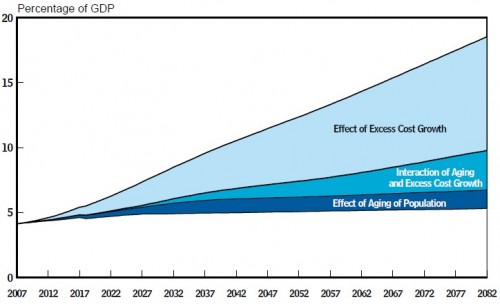There is an often-repeated claim that retiring baby boomers have a lot to do with future increases in federal spending, which is itself dominated by Medicare spending. There is something to it, but not as much as one would think. This graph, produced by Peter Orszag, shows it:
Medicare Spending
About this graph, I once wrote,
The bottom area shows how much Medicare spending would grow if health care costs stayed fixed. That is, it is only a function of population aging. This is the “demography is destiny” part. The top area is growth associated with health care cost inflation, fixing the population as it was in 2007. This is growth purely due to health care costs. The middle area is the cost growth associated with increasing health costs applied to newly entitled individuals, those added to Medicare rolls after 2007. One could argue whether this is attributable to population growth or health care cost growth. It’s both. But the fact is, if health costs per person didn’t grow this band would cease to exist.
Today Paul Krugman adds an important point. Even if the aging population is not the main driver of costs, it is a bigger factor in deficits because it has an effect on revenue.
First and most obviously, the baby boomers are retiring. Look at the old-age dependency ratio. For the past 20 years we’ve had about 21 Americans over 65 for every 100 Americans between 20 and 64. But by 2020 that number will rise to 27.5; by 2030 it will rise to 35.
Somebody has got to pay for what Medicare beneficiaries use. In large part it has been younger workers. That’s likely to continue, though that’s not a logical necessity. Suppose it does though. With fewer workers per retiree, each will have to pay more or else deficits will grow. So, demography is (somewhat) destiny but not the whole story. Health care costs are a huge part of the story.



